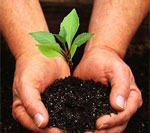What does carbon neutral mean?
Carbon neutrality is a hot topic right now. Scientists have identified (and most governments have accepted) that human technological activities are the root cause of global warming and climate change. The primary issue is the high level of Carbon Dioxide that is released into the atmosphere by burning fossil fuels such as oil and coal.
This has made many feel guilty about their impact on the environment and has lead to the concept to carbon neutrality. Being carbon neutral basically means that any carbon you emit is counteracted or offset by positive environmental actions.
One common method for attaining carbon neutrality is the planting of trees. Trees are excellent systems for extracting and absorbing atmospheric carbon dioxide.
Critics believe that trees are not a sufficient answer to the problems we face. This might be true in the long term but at present they are one of the best things we have in our arsenal to combat our global impact.
Advantages of trees:
- Available for use now
- Low cost
- Low maintenance
- Visually appealing
- Mature (finished) product has other uses
Information about our trees
Rather than planting the fastest growing or cheapest trees, we are making a dedicated effort to propagate and source quality hardwoods and native trees.
The reason for choosing hardwoods is that although they grow slower they usually grow much larger locking in even more carbon. Because they live longer and the wood is more resilient to rot and decay, hardwoods are a much more suitable option.
What happens to the trees in the future?
While living, trees sequester and store carbon in their cellular structure. Once dead, wood left in the elements rots and becomes a fire hazard, both of which return the carbon to the atmosphere in the form of C02.
To prevent this from happening and to free up valuable land for the planting of yet more trees, mature trees near the end of their life may be harvested, preserving the wood for use in local housing schemes.
